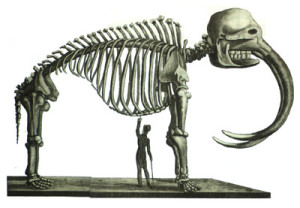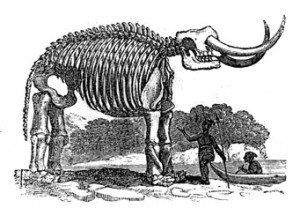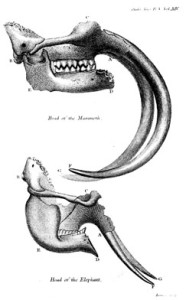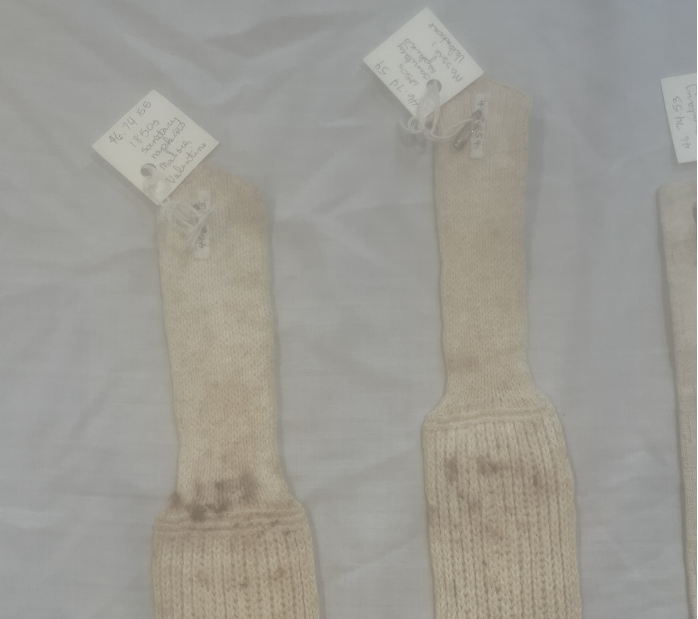In 1806, when Meriwether Lewis and William Clark returned from their historic expedition, the greatest curiosity on display in the new republic was the eleven-foot-tall skeleton of the American incognitum, or “mammoth.” The animal’s bones were a prize attraction at the Philadelphia Museum owned by the portrait artist and polymath Charles Willson Peale. Peale’s American incognitum was famous throughout the land thanks to newspaper reports, museum exhibits, and President Thomas Jefferson´s well-publicized efforts to acquire its bones.
Excavated by Peale from a farm in the Hudson River Valley in 1801, the skeleton belonged then to an unknown species, later identified as the mastodon. In an era when there was little awareness of extinction or the prehuman past, the animal’s identity had been a subject of vigorous debate for nearly a century in both Europe and America. Naturalists on both sides of the Atlantic had puzzled over the bones ever since the first discovery of a giant tooth on the banks of the Hudson River in the early eighteenth century. What was this enormous animal for which no living counterpart could be found? Was it a harmless herbivore or a ferocious carnivore? Were its descendants still living in the unexplored parts of the American West? Or did its remains belong to an extinct species whose disappearance was God’s blessing upon the new nation?
The skeleton preoccupied American patriots for another reason less scientific in nature–one which helps to explain why its bones were eagerly sought after by the Founding Fathers during and after the Revolutionary War. For many Americans, the great beast had become a symbol of the new nation’s own conquering spirit–an emblem of overwhelming power in a psychologically insecure society. For them the animal’s symbolic meaning far outweighed its scientific significance as evidence of extinct species or a prehuman past. While the mastodon did not compete with the bald eagle as the nation’s official emblem, this majestic Ice Age creature did become an informal icon of national identity for citizens of the new republic.
Indeed, while Lewis and Clark were exploring the western wilderness, Peale had remounted his skeleton with its tusks pointing downward to magnify its ferocity (fig. 1). Many patrons of his museum imagined the unknown creature to be a ferocious carnivore, an elephant with claws that devoured buffalo, deer, and elk. Unfortunately, this image of the skeleton with its downturned tusks has become an obscure footnote in the abundant literature now available on Charles Willson Peale and his remarkable family. Historians seem to regard it as an embarrassing lapse in the enlightened rationality of the Peales, not to mention the Founding Fathers who helped to create the myth of the mastodon. As a result, few people today are aware that the mastodon was the nation’s first prehistoric monster, or that the Founding Fathers made this animal a symbol of dominance in the first decades of the new republic.
Rather than dismissing the wrongly mounted tusks as quack science, we need to delve deeper into the hidden meaning of this misbegotten monster. The story of Peale’s skeleton demonstrates why such curiosities should not be dismissed as Barnumesque aberrations. In many respects, Peale’s American monster embodied a natural history myth that still exists today: the belief that monstrous carnivores actually “ruled” prehistoric nature, as if they were ruthless tyrants. Newscasters, novelists, filmmakers, and scientists alike routinely tell us that dinosaurs “ruled” the earth for 150 million years, even though the metaphor of ruling species has no scientific basis. Evidently, we have a powerful desire to portray fearsome beasts of prey as rulers of prehistoric nature. Fortunately, Peale’s skeleton provides us with valuable insights into the historical roots of this extravagant metaphor and the paradigm of dominance that the myth of the mastodon helped to create. As early-nineteenth-century Americans set out to conquer the western wilderness, this mythical creature helped them imagine themselves as new rulers of the natural world.
Before Meriwether Lewis left for the West in 1803, President Jefferson sent him to Philadelphia to receive advice from the nation’s leading naturalists about scientific aspects of his expedition. While in the city Lewis almost certainly visited Peale’s Museum and viewed the skeleton of the incognitum. An avid collector of its bones, Jefferson no doubt informed Lewis of his own belief the animal was not extinct. Historical record reveals that he instructed Lewis to look not only for bones, but for living “mammoths” in the unexplored western territories.
No one was sure what living mammoths would be like, but many citizens believed they could be dangerous carnivores. In Philadelphia, Dr. Caspar Wistar, the nation’s foremost anatomist, showed Lewis the animal’s giant grinders (fig. 2). The knobby protrusions on the molars differed from the flat grinding surface on the molars of living elephants and of Siberian mammoths. The teeth raised questions about the animal’s identity and its possible extinction, but they were also the center of a lively debate over its diet and demeanor.

Thirty-five years earlier, the distinctive shape of the animal’s tooth had led England’s foremost surgeon and anatomist, Dr. William Hunter, to declare that the American incognitum was not only an extinct species, but a carnivore as well. “If this animal is indeed carnivorous,” he wrote, “though we may as philosophers regret it, as men we cannot but thank Heaven that its whole generation is probably extinct.” On the eve of the American Revolution, Dr. Hunter gave the Founding Fathers a rationale for making the great beast a symbol of the new nation. If the American monster was a ferocious carnivore, it was convincing evidence of American superiority, an enormous quadruped that could surely best the British lion, the emblem of Britain’s imperial power.
Passages in Thomas Jefferson’s Notes on the State of Virginia, first drafted during the Revolutionary War, helped to make the unknown creature a national symbol. “To whatever animal we ascribe these remains,” he wrote, “it is certain that such a one has existed in America, and that it has been the largest of all terrestrial beings.” For Jefferson, the animal’s existence refuted the humiliating theory of American degeneracy propounded by the famous French naturalist George Louis Leclerc de Buffon, who claimed that all species in America, including the humans, were smaller, weaker, and generally inferior to those of the Old World.
Other American writers joined in celebrating the animal’s existence, adding to its mythical stature after the Revolutionary War. Big Bone Lick in the Ohio River Valley, the principal source of the animal’s bones, figured prominently in John Filson’s The Discovery, Settlement and Present State of Kentucke (1784), the country’s first best seller. Readers picked up Filson’s book to learn the story of the frontier hero Daniel Boone, but along the way they encountered the American monster.
Filson depicted the Kentucky frontier as a howling wilderness inhabited by wild beasts and uncivilized savages. The myth of wild nature, a common feature of frontier literature, bolstered Filson’s view of the American monster as “the tyrant of the forests, perhaps the devourer of man!” Ironically, this early view of the mastodon as a ruling species proved useful in solving a problem posed by the discovery of a prehuman past. The first perceptions of prehistoric nature revealed the existence of a vast realm of natural history where, owing to the absence of humans, there was no dominant species. “What was this primitive earth? What was this nature that was not subject to man’s dominion?” asked the French anatomist Georges Cuvier. Viewing the American monster as a ruling species helped preserve the idea of a hierarchy in the natural world–an idea essential to Christian civilization’s view of God’s nature.
George Washington’s inauguration as the nation’s first president in 1789 unleashed a new wave of patriotic fervor that spurred the search for a complete mammoth skeleton or, better yet, a living specimen. Washington himself had collected a giant molar from the Ohio Country before the Revolutionary War. During the hostilities he viewed similar bones discovered on a farm near his headquarters in the Hudson River Valley.
In the 1790’s the search for bones became an obsession for many American patriots. “The vast Mahmot, is perhaps yet stalking through the western wilderness,” Reverend Nicholas Collin told members of the American Philosophical Society. “But if he is no more, let us carefully gather his remains, and even try to find a whole skeleton of this giant, to whom the elephant was but a calf.” Journal articles and pamphlets appeared celebrating the animal’s awesome size and appetite. A romanticized version of a Native American legend first mentioned in Jefferson’s Notes was typical of the hyperbole American patriots used to describe the animal: “Forests were laid waste at a meal, the groans of expiring animals were everywhere heard; and whole villages, inhabited by men, were destroyed in a moment.” According to this anonymous author, the great beast was not extinct, but rather reigned as “the uncontrolled Monarch of the Wilderness” somewhere in the unexplored north country. In 1795, the New York physician Dr. Samuel Latham Mitchill conjured up another terrifying image of the American monster in a speech he delivered to the Tammany Society, describing the legendary chief Tammany’s battles with “alarming droves of mammoths, carnivorous animals, especially loving to feed upon human flesh.”
Educated Americans often augmented the great beast’s ferocity as they sought to solve the riddle of the animal’s identity. In a paper presented to the American Philosophical Society in 1797, Judge George Turner imagined the unknown animal to be an elephant-like creature armed with small claws: “With the agility and ferocity of the tiger, with [a] body of unequaled magnitude and strength, it is possible the Mammoth may have been at once the terror of the forest and of man!” Like many citizens of the new republic, Judge Turner believed the American monster to be carnivorous. After all, Jefferson had cited Native American legends to this effect to support his belief the animal was not extinct: “Their tradition is that it was carnivorous and still exists in the northern parts of America,” he wrote. Not surprisingly, when Peale finally excavated the first complete skeleton in the Hudson River Valley, there were expressions of awe at what viewers believed to be evidence of the animal’s voracious appetite. “Gracious God, what a jaw! how many animals have been crushed by it?” exclaimed Peale’s son Rembrandt as workmen unearthed a massive jawbone.
As their preliminary drawings indicate, when the Peales first mounted the skeleton, they inserted the tusks pointing upward like those of plant eating elephants, although the broadside advertising the exhibit emphasized the unknown animal’s carnivorous nature. Even though the question of the animal’s diet was a subject of debate, Peale regaled his museum patrons with tales of a race of animals “huge as the frowning precipice, cruel as the bloody panther, swift as the descending eagle, and terrible as the Angel of Night.” Myth and metaphor mingled with scientific fact in Peale’s characterization of the beast. In New York, where a second skeleton was exhibited during the summer of 1802, his son Rembrandt identified the creature as “the Behemoth or Mammoth, an animal with teeth of the carnivorous kind.” One of the first public images of the skeleton, a drawing by Alexander Anderson, the nation’s leading woodcut artist, showed The Mammoth of New York mounted with its tusks pointing upward (fig. 3).
When Meriwether Lewis first visited Peale’s Philadelphia Museum in 1803, the skeleton still had its tusks mounted like an elephant’s. The idea to remount the tusks so they pointed downward like a killer carnivore came from Rembrandt Peale, who was then in London exhibiting the second skeleton. In a pamphlet published there in the fall of 1802, he expressed for the first time doubts about the mounting of the animal’s tusks: “It is the opinion of many, that these tusks might have been reversed in the living animal, with their points downwards,” he wrote. “But as we know not the kind of enemy it had to fear, we judged only by analogy in giving them the direction of the elephant.” Within a few months, Rembrandt had remounted the tusks of the London skeleton. “In the inverted position of the tusks he could have torn an animal to pieces held beneath his foot,” he wrote. Drawings by Rembrandt Peale comparing the heads of an elephant and the “Mammoth” appeared in London’s Philosophical Magazine, to illustrate an article explaining his reversal of the tusks (fig. 4). Very likely, upon his return to Philadelphia in the fall of 1803, Rembrandt convinced his father to reverse the tusks on the skeleton in the Philadelphia Museum.
Displayed in gilt frames in the Mammoth Room alongside the skeleton, Rembrandt’s London pamphlet also brought to the attention of museum patrons the disturbing idea of the animal’s extinction. “We are forced to submit to concurring facts as the voice of God,” Rembrandt wrote; “the bones exist, the animals do not!” Even as Lewis and Clark were searching the western wilderness for signs of the living monster, many Americans were coming to accept the animal’s extinction. They may not have been ready to accept the fossilized remains as evidence of a prehuman world, but as they came to see the monster as a symbol of dominance, they accepted its disappearance as yet another of God’s blessings on the new nation.
Even after it became evident the monster was neither a meat eater nor living, the myth of the mastodon continued to flourish. Much to Jefferson’s dismay, Lewis and Clark returned to Washington in 1806 without either reports of living mammoths, or any of the dead animal’s bones. That same year the French anatomist Georges Cuvier resolved the mystery of the animal’s identity by declaring the creature to be an extinct species and naming it the mastodon. Although Cuvier clearly designated the animal as an herbivore, the skeleton at Peale’s Museum remained mounted with its tusks pointing downward for at least another decade. In December 1816, Édouard de Montulé, a French traveler, visited Philadelphia and made a drawing of the skeleton with its menacing tusks, an image published several years later in the travelogue of his trip (fig. 1).
In 1822, Charles Willson Peale created another monumental image of this icon of American identity. In his self-portrait The Artist in His Museum, painted when he was eighty-six, the mounted skeleton is visible in the shadows. By leaving the position of its tusks in doubt, Peale preserved the creature’s symbolic significance. In the foreground at Peale’s feet lay the giant molar that had prompted many to believe the beast was a carnivore. Four years later, John Godman, a young Philadelphia physician, testified to the animal’s enduring symbolism as a ruling species in his drawings and description of Peale’s skeleton: “The emotions experienced, when for the first time we behold the giant relics of this great animal, are those of unmingled awe,” he exclaimed, while noting that “the mastodon strode along in supreme dominion over every other tenant of the wilderness.”
The mastodon continued to have a mythic status even after its diet was defined as herbivorous and its tusks remounted pointing upward. In 1839, the New York author Cornelius Mathews published a short novel entitled The Behemoth in which the mastodon was portrayed as a monster that had destroyed cities erected by the continent’s ancient mound builders. “The whole wilderness presented an appearance as if it had been recently trampled by some angry and barbaric puissance, that had swept it from end to end like a storm,” he wrote. In the summer of 1845, the discovery of another well-preserved mastodon skeleton in the Hudson River Valley stirred similar thoughts in the mind of Samuel Eager, a local historian. “Contemplating these remains as exhumed from their resting place for unknown ages, we instinctively think of his great and lordly mastery over the beasts,” he wrote. “The mind quails beneath the oppressive grandeur of the thought, and we feel as if driven by the violence of a tornado.”
For many Americans, the mastodon continued to be a symbol of dominance, a “ruling species” that was a forerunner of the prehistoric monsters to come in the ensuing age of Darwin and the dinosaurs. Long before the publication of Darwin’s Origin of Species (1859), the myth of the mastodon led Americans to envision a prehuman past where violent conquest and domination were believed to be natural. For American patriots, the savagery of prehistoric nature both mirrored their view of the western wilderness and their desire to conquer this vast unexplored territory. In many ways, the idea that helped to give birth to this paradigm of dominance was the myth of wild nature, a view of the natural world that served to justify both the colonization of the New World and the conquest of the American West.
Ironically, a few years later Peale’s Philadelphia Museum went bankrupt and the mastodon’s skeleton was sold to European collectors to pay off creditors. For over a century, the skeleton disappeared from American history, until it was rediscovered in the 1950’s in the Hessisches Landesmuseum in Darmstadt, Germany, where it can be seen today. Because of the beast’s disappearance, few people now are aware that the myth of the mastodon set the stage for our own view of prehistoric nature. Long before we told children tales of Tyrannosaurus rex,American patriots created a natural history myth that still shapes the way we portray such creatures: the myth of ruling species in prehistoric nature. Perhaps the current popularity of monstrous predators in science and popular culture, a fantasy of absolute power for children and adults alike, will prompt us to take this curious skeleton in our closet more seriously and to question our own casual acceptance of the paradigm of dominance. Such myths and metaphors often express our most basic values and beliefs. They are the mental constructs that need to be reinvented if we are to give cultural life to values other than those of violent conquest and domination.
Further Reading: Aside from the titles cited in the text, this essay is drawn from a wide variety of eighteenth and early-nineteenth-century primary sources ranging from broadsides, pamphlets, and correspondence to novels, scientific treatises, and journal articles. Rembrandt Peale’s Disquisition on the Mammoth, or, Great American Incognitum (London, 1803) provides a firsthand account of the excavation of Peale’s mastodon, along with elements of the mythmaking that accompanied its discovery. The Collected Papers of Charles Willson Peale and His Family, a microform compilation edited by Lillian B. Miller, contains a vast amount of hard to find information about Charles Willson Peale’s career. For less ambitious readers, the cream of this collection has been published in a four volume set entitled The Selected Papers of Charles Willson Peale and His Family (New Haven, 1993-96). Mr. Peale’s Museum (New York, 1980) by Charles Coleman Sellers has a readable chapter devoted entirely to the discovery and display of Peale’s American incognitum. John Godman’s American Natural History (Philadelphia, 1826) offers an early scientific description of the skeleton, along with drawings of the bones. Thomas Jefferson’s Notes on the State of Virginia (London, 1785) is an indispensable source of information about the emergence of the mastodon as a national symbol. Details pertaining to Lewis and Clark are drawn mainly from the correspondence of Jefferson, Meriwether Lewis, and William Clark. Other evidence of the Founding Fathers’ fascination with the bones comes from their correspondence as well as published commentaries by contemporary figures on the various discoveries made prior to Peale’s excavation. Anyone wishing to explore the paradigm of dominance in contemporary culture should consult W. J. T. Mitchell’s The Last Dinosaur Book, a delightful and profound examination of our current obsession with dinosaurs. For the full story of the myth of the mastodon and a complete bibliography of sources see Paul Semonin’s American Monster: How the Nation’s First Prehistoric Creature Became a Symbol of National Identity (New York, 2000) and also Paul Semonin’s Website: www.americanmonster.net.
This article originally appeared in issue 4.2 (January, 2004).
Paul Semonin is author of American Monster: How the Nation’s First Prehistoric Creature Became a Symbol of National Identity (New York, 2000). His articles on natural history and American nationalism have appeared in Leonardo and the Northwest Review. He is currently working on a video documentary based upon his book.






















